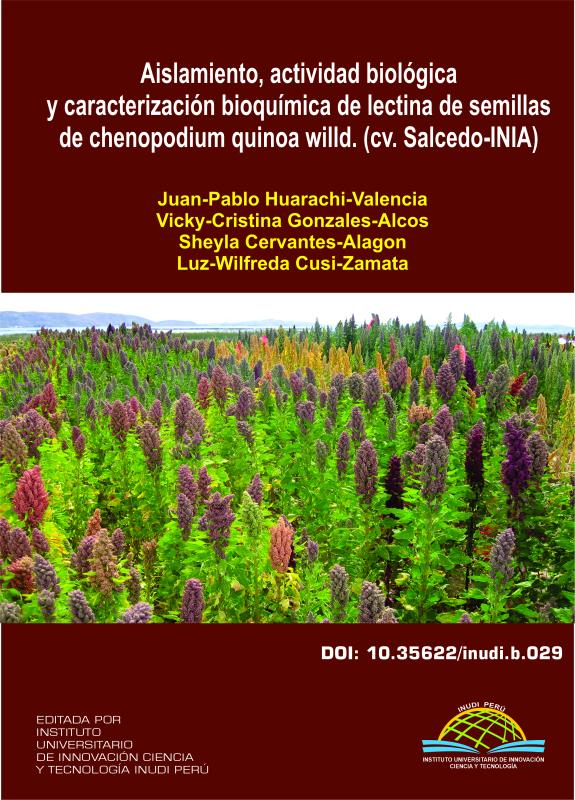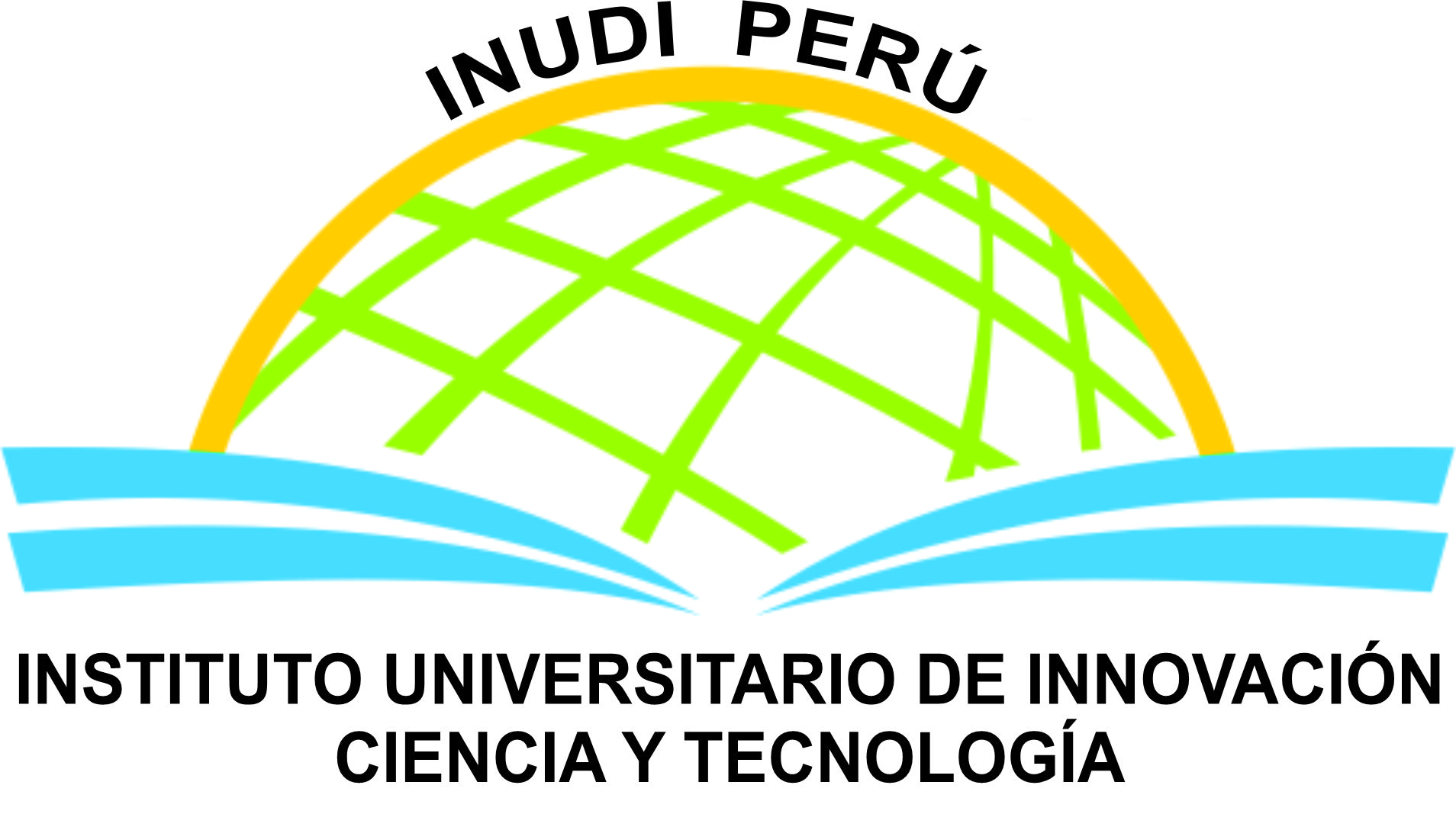Aislamiento, actividad biológica y caracterización bioquímica de lectina de semillas de chenopodium quinoa willd. (cv. Salcedo-INIA)
Palavras-chave:
lectina, Chenopodium quinoa, bactoaglutinación, actividad insecticidaSinopse
Las lectinas actúan como moléculas de reconocimiento celular, y probablemente en la defensa vegetal. La CqLEC, lectina de Ch. quinoa cv Salcedo INIA, fue aislada, purificada y caracterizada a partir de 70 g de semillas a través de extracción salina, y la combinación de dos cromatografías de exclusión molecular tales como las de Sephadex G-100 y G-75 logrando obtenerse 5,53 mg/ml de proteína con actividad hemaglutinante, así como por HPLC de fase reversa a los 32 minutos con 54 % de tampón B indicando que poseía un bajo número de residuos hidrofóbicos en su estructura. Asimismo, el SDS-PAGE demostró que la lectina purificada fue homogénea ya que presentaba un solo componente correspondiente a una proteína de 12,82 kDa. Siendo que la CqLEC aglutinó eritrocitos humanos del grupo sanguíneo “O Rh+” con una CMH de 1,95 mg/ml, inhibido por fucosa (0,78 mM) y el agente quelante EGTA (0,1 mM), esto indicaba que sería una lectina ligadora de fucosa dependiente de iones divalentes tales como el calcio o el manganeso. Por otra parte, esta proteína mostró una bactoaglutinación específica para E. coli (CMB igual a 200 mg/ml), así como actividad insecticida en contra de larvas de Symmetrischema plaesiosema (1000 ppm of CqLEC, P < 0,05). El análisis completo de aminoácidos reveló que la CqLEC es una lectina de naturaleza ácida (70,54 % de residuos hidrofílicos y 29,46 % de residuos hidrofóbicos), prevaleciendo el ácido glutámico (33 %), con una masa molecular de 12,859 kDa. Por estudio de homología secuencial se determinó que ésta pertenece a la familia de lectinas vegetales de Leguminosas, mostrando 82,1 % de similitud con el precursor de la aglutinina I extraída a partir de la corteza de Cladrastis kentukea. La CqLEC también presentó residuos altamente conservados en su estructura tales como Leu 4, Ser 6 y Phe 7.
Referências
Adar, R. & Sharon, N. (1996). Mutational studies of the amino acid residues in the combining site of Erythrina corallodendron lectin. Eur J Biochem. 239 (3): 668-674.
Ali, N. (1991). Soluble -galactoside binding lectins: physicochemical and functional properties. Biochem. Edu. 19: 2-6.
Álvarez, D., De la Fuente, J., Villarubia, O., Menéndez, J. y Ortiz, E. (2003). Actividad biológica de Ricinus communis sobre mosca doméstica (Musca domestica). Rev. Cubana Med. Trop. 48 (3): 192-194.
Ayala, C. (1977). Efecto de localidades en el contenido de proteínas en quinua (Chenopodium quinoa Willd.). Tesis de Ing. Agro. Facultad de Agronomía. Universidad Nacional Técnica del Altiplano. Puno - Perú.
Ayouba, A., Causse, H., Van Damme, E., Peumans W., Cambillau, C. & Rougé, P. (1994). Interactions of plant lectins with the components of the bacterial cell wall peptidoglycan. Biochem Syst Ecol. 22: 153-159.
Bao, J., Wu, C., Zhang, J., Lu, H., Wang, K. & Long, H. (2001). The characterization and biological activity of Lycoris radiata agglutinin – a lectin F. 19th INTERLEC. Brazil.
Barbieri, L., Battelli, M. & Stirpe, F. (1993). Ribosome-inactivating proteins from plants. Biochim Biophys Acta. 1154 (3-4): 237-282.
Barondes, S., Cooper, D., Gitt, M. & Leffler, H. (1994). Galectins. Structure and function of a large family of animal lectins. J Biol Chem. 269 (33): 20807-20810.
Bertero, H., King, R. & Hall, A. (1999). Photoperiod-sensitive development phases in quinoa (Chenopodium quinoa Willd.). Field Crops Res. 60: 231-243.
Bidlingmeyer, B., Cohen, S. & Tarvin, T. (1984). Rapid analysis of amino acids using precolumn derivatization. J.Chromat. 33: 93-104.
Bing, D., Weyand, J. & Stavitsky, A. (1967). Hemagglutination with aldehyde-fixed erythrocytes for assay of antigens and antibodies. Proc Soc Exp Biol Med. 124 (4): 1166-1170.
Birren, B. (2003). Direct Submission. Submitted Whitehead Institute/MIT Center for Genome Research, 320 Charles Street, Cambridge, MA 02142. USA.
Blake, C. & Johnson, L. (1984). Protein structure. TIBS. 147-151.
Blanco, Je., Blanco, M., Blanco, J., Mora, A., Balaguer, L., Mouriño, M., Juárez, A. & Jansen, W. (1996). O serogroups, biotypes and eae genes in Escherichia coli isolated from diarrheic and healthy rabbits. J. Clin. Microbiol. 34: 3101-3107.
Bohlool, B. & Schmidt, E. (1974). Lectins: A possible basis for specificity in the Rhizobium-legume root nodule symbiosis. Science. 185: 269-271.
Broekaert, W. & Peumans, W. (1986). Lectin release from seeds of the Datura stramonium and interference of the Datura stramonium lectin with bacterial motility. In TC Bog-Hansen, E Van Driessche, eds, Lectins, Biology, Biochemistry, Clinical Biochemistry, Vol 5. Walter de Gruyter, Berlin, pp 57-65.
Broekaert, W., Van Parijs, J., Leyns F., Joos H. & Peumans, W. (1989). A chitin-binding lectin from stinging nettle rhizomes with antifungal properties. Science. 245: 1100-1102.
Broekaert W., Marien W., Terras F., De Bolle M., Proost P., Van damme J., Dillen L., Claeys M., Rees S., Vanderleyden J. & Cammue B. (1992). Antimicrobial peptides from Amaranthus caudatus seeds with sequence homology to the cysteine/glycine-rich domain of chitin-binding proteins. Biochemistry. 31: 4308-4314.
Carvalho M. & Sgarbieri V. (1998). Relative importance of phytohemagglutinin (lectin) and trypsin-chymotrypsin inhibitor on bean (Phaseolus vulgaris L) protein absorption and utilization by the rat. J Nutr Sci Vitaminol (Tokyo). 44 (5): 685-696.
Carvalho D., Marangoni S., Oliveira B. & Novello J. (1998). Isolation and characterization of a new lectin from the venom of the snake Bothrops jararacussu. Biochem. Mol. Biol. Inter. 44 (5): 933-938.
Ceccatti, J. (2004). Resisting insects: shifting strategies in chemical control. Endeavour. 28 (1): 14-19.
Chothia, C. (1984). Principles that determine the structure of proteins. Ann. Rev. Biochem. 53: 537-572.
Chrispeels, M. & Raikhel, N. (1991). Lectins, Lectin genes, and their role in plant defense. Plant Cell. 3: 1-9.
Collinge, D., Kragh, K., Mikkelsen, J., Nielsen K., Rasmussen, U. y Vad, K. (1993). Plant chitinases. Plant J. 3: 31-40.
Costa, F., Sampaio, A., Neves, S., Rocha, M., Benavides, M. & Freitas, A. (1999) Purification and characterization of a lectin from the red marine alga Amansa multifida. Physiol. Mol. Biol. Plants. 5: 53-61.
Coulter, L. & Lorenz, K. (1990). Quinoa, composition nutritional value, food application. Lebensmittel-Wissenschaft Technologie. 3: 203-207.
Czapla, T. & Lang, B. (1990). Effect of plant lectins on the larval development of European corn borer (Lepidoptera: Pyralidae) and Southern corn rootworm (Coleoptera: Chrysomelidae). J. Econ. Entomol. 83: 2480-2485.
De Miranda Santos, I. & Pereira, M. (1984). Lectins discriminate between pathogenic and nonpathogenic South American trypanosomes. Am J Trop Med Hyg. 33 (5): 839-844.
Diaz, C., Melchers, L., Hooykaas, P., Lugtenberg, B. & Kijne, J. (1989). Root lectin as a determinant of host-plant specificity in the Rhizobium-legume simbiosis. Nature. 338: 579-581.
Drickamer, K. (1988). Two distinct classes of carbohydrate-recognition domains in animal lectins. J Biol Chem. 263(20): 9557-9560.
Drickamer, K., Dordal, M. & Reynolds, L. (1986). Mannose-binding proteins isolated from rat liver contain carbohydrate-recognition domains linked to collagenous tails. Complete primary structures and homology with pulmonary surfactant apoprotein. J Biol Chem. 261(15): 6878-6887.
Edman, P. & Begg, G. (1967). A protein sequenator. Eur J Biochem.1: 80-91.
Etzler, M. (1986). Distribution and function of plant lectins. In the Lectins, I.E. Liener, N. Sharon, e I.J. Goldstein, eds (San Diego; Academic Press), pp. 371-435.
Fountain, D., Foard, D., Replogle, W. & Yang, W. (1977). Lectin release by soybean seeds. Science. 197: 1185-1187.
Freire, M., Machado, O., Smolka, M., Marangoni, S., Novello, J. & Macedo M. (2001a). Isolation and characterization of isolectins from Talisia esculenta seeds. J. Protein. Chem. 20 (6): 495-500.
Freire, M., Silva, A., Lima, M., Marangoni, S., Novello, J. & Macedo, M. (2001b). TEL a novel lectin from Talisia esculenta seeds: isolation and cell migration inducing. 19th INTERLEC. Brazil.
Gabius, H. (1994). Non-carbohydrate binding partners/domains of animal lectins. Int J Biochem. 26 (4): 469-477.
Gandarillas, H. & Luizaga J. (1969). Número de cromosomas de Chenopodium quinoa Willd. en radículas y raicillas. Turrialba 17 (3): 275-279.
Girbes, T., Ferreras, J., Iglesias, R., Citores, L., De Torre, C., Carbajales, M., Jiménez, P., De Benito, F. & Muñoz, R. (1996). Recent advances in the uses and applications of ribosome-inactivating proteins from plants. Cell Mol Biol. 42 (4): 461-471.
Goldstein, I. & Hayes, C. (1978). The lectins: Carbohydrate binding proteins of plants and animals. Adv. Carbohydr. Chem. Biochem. 35: 127-340.
Grant, G., More, L., Mckenzie, N., Dorward, P., Stewart, J., Telek, Y. & Pusztai, A. (1991). A survey of the nutritional and haemagglutination properties of several tropical seeds. Livestock Research for Rural Development. Vol. 3, N° 3.
Guinée, P., Agterberg, C. & Jansen, W. (1972). Escherichia coli O antigen typing by means of a mechanized microtechnique. Appl. Microbiol. 24:127-131.
Henrikson, R. & Meredith, S. (1984). Amino acid analysis by reverse-phase high performance liquid chromatography in differentiating mouse astrocytes in primary culture. Dev. Neurosci. 1:226 -267.
Hirabayashi, J., & Kasai, K. (1991). Effect of amino acid substitution by sited-directed mutagenesis on the carbohydrate recognition and stability of human 14-kDa beta-galactoside-binding lectin. J Biol Chem. 266 (35): 23648-23653.
Hoffman, L. & Donaldson, D. (1985) Characterization of two Phaseolus vulgaris phytohemagglutinin genes closely linked on the chromosome. EMBO J. 4: 883-889.
Hudak, K., Wang, P. & Tumer, N. (2000). A novel mechanism for inhibition of translation by pokeweed antiviral protein: depurination of the capped RNA template. RNA 6: 369–380.
Huesing, J., Murdock, L. & Shade, R. (1991a). Effect of wheat germ isolectins on development of cowpea weevil. Phytochemistry. 30: 785-788.
Huesing, J., Murdock, L. & Shade, R. (1991b). Rice and stinging nettle lectins: insecticidal activity similar to wheat germ agglutinin. Phytochemistry. 30: 3565-3568.
Hynes, S., Hirmo, S., Wadström, T. & Moran, A. (1999). Differentiation of Helicobacter pylori isolates based on lectin binding of cell extracts in an agglutination assay. Journal of Clinical Microbiology. 37 (6): 1994-1998.
INIA (1997). "El cultivo de quinua Chenopodium quinoa Wild". Serie plegable Nº 7-97. Lima-Perú.
Jiro, D., Silva, J., Novello, J. & Marangoni, S. (2002). Purificação, caracterização bioquímica e funcional de lectinas em sementes de Chenopodium quinoa. X Congresso Interno de Iniciacao Científica da UNICAMP. Brazil.
Kini, R. (1996). Are C-type lectin-related proteins derived by proteolysis of metalloproteinase/disintegrin precursor proteins?. Toxicon. 34 (11-12): 1287-1294.
Kolberg, J. & Sletten, K. 1982 Purification and properties of a mitogenic lectin from Lathyrus sativus seeds. Biochim Biophys Acta. 704 (1): 26-30.
Konishi, Y., Hirano, S., Tsuboi, H. & Wada, M. (2004). Distribution of minerals in quinoa (Chenopodium quinoa Willd.) seeds. Biosci. Biotechnol. Biochem. 68 (1): 231-234.
Koziol, M. (1992). Chemical composition and nutritional evaluation of quinoa (Chenopodium quinoa Willd.). J. Food Comp. Anal. 5: 35-68.
Laemmli, U. (1970). Cleavage of structural proteins during the assembly of the head of bacteriophage T4. Nature. 227 (259): 680-685.
Leite, K., Ramos, M., Castellón, R., Maia, C., Gurgel, M., Souza, L. & Cavada, B. (2001). Purification, chemical and inmunochemical properties of a nw lectin from Mimosoideae (Parkia discolor). 19th INTERLEC. Brazil.
Lerouge, P., Roche, P., Faucher, C., Maillet, F., Truchet, G., Promé, J. & Denarie, J. (1990). Symbiotic host-specificity of Rhizobium meliloti is determined by a sulphated y acylated of glucosamina oligosaccharide signal. Nature. 344: 781-784.
Lis, H. & Sharon, N. (1986). Lectins as molecules and as tools. Annu Rev Biochem. 55: 35-67.
Lis, H. & Sharon, N. (1987). Erythrina lectins. Methods Enzymol. 138: 544-551.
Loris, R. (2002). Principles of structures of animal and plant lectins. Biochim Biophys Acta. 1572: 198-208.
Mujica, A. (1997). Cultivo de Quinua. Instituto Nacional de Investigación Agraria. Serie Manual RI N° 1-97. Lima-Perú.
Murdock, L., Huesing, J., Nielsen, S., Pratt, R. & Shade, R. (1990). Biological effects of plant lectins on the cowpea weevil. Phytochemistry. 29: 85-89.
Nicholls, C. & Mulley, J. (1982). Distribution of the GC (group-specific component) subtypes in cord bloods and blood donors. Aust J Exp Biol Med Sci. 60 (4): 427-431.
Nowak, T., Haywood, P. & Barondes, S. (1976). Developmentally regulated lectin in embryonic chick muscle and a myogenic cell line. Biochem Biophys Res Commun. 68 (3): 650-657.
Oliveira, J., Melo, V., Camara, M., Vasconcelos, I., Beltramini, L., Machado, O., Gomes, V., Pereira, S., Fernández, C., Nunes, E., Monteiro, A. (2001). Purification and phisicochemical characterization of a legume lectin from Luetzelburgia auriculata. 19th INTERLEC. Brazil.
Olsson, M. & Chester, M. (2001). Polymorphism and recombination events at the ABO locus: a major challenge for genomic ABO blood grouping strategies. Transfusion Medicine. 11 (4): 295-313.
Osborn, T., Alexander, D., Sun, S., Cardone, C. & Bliss, F. (1988). Insecticidal activity and lectin homology of arcelin seed protein. Science. 240: 207-210.
Ozeki, Y., Matsui, T. & Titani, K. (1991). Cell adhesive activity of two animal lectins through different recognition mechanisms. FEBS Lett. 289 (2): 145-147.
Ozeki, Y., Tazawa, E. & Matsui, T. (1997). D-galactoside-specific lectins from the body wall of an echiuroid (Urechis unicinctus) and two annelids (Neanthes japonica and Marphysa sanguinea). Comp Biochem Physiol B Biochem Mol Biol. 118 (1): 1-6.
Pereira, M., Melo, F., Silveira, V., Nascimento, A. & Benevides, N. (2001). Purification and partial characterization of the lectin from the alga Ulva fasciata. 19th INTERLEC. Brazil.
Peumans, W. & Van Damme, E. (1995). Lectins as plant defense proteins. Plant Physiol. 109 (2): 347-352.
Peumans, W., Hao Q. & Van Damme, E. (2001). Ribosome-inactivating proteins from plants: more than RNA N-glycosidases?. The FASEB Journal. 15: 1493-1506.
Peumans, W. & Van Damme, E. (2001). Taxonomical distribution of plant lectins. 19th INTERLEC. Brazil.
Poretz, R., Tang, M. & Vucenik, I. (1986). The separation of lymphocyte subpopulations with lectins. Immunol Invest. 15 (6): 521-529.
Portugal, M., Silva, J., Novello, J. & Marangoni, S. (2002). Estudo da atividade mitogênica da lectina de sementes de Chenopodium quinoa (Cqlec) sobre linfócitos e seu encapsulamento em lipossomos. X Congresso Interno de Iniciacao Científica da UNICAMP. Brazil.
Prakash, D., Nath, P. & Pal, M. (1993). Composition, variation of nutritional contents in leaves, seed protein, fat and fatty acid profile of Chenopodium species. Journal of the Science of Food and Agriculture.62: 203-205.
Prego, I., Maldonado, S. & Otegui, M. (1998) Seed structure and localization of reserves in Chenopodium quinoa. Annals of Botany. 82: 481-488.
Pusztai, A., Ewen, S., Grant, G., Peumans, W., Van Damme, E., Rubio, L. & Bardocz, S. (1990). The relationship between survival and binding of plant lectins during small intestine passage and their effectiveness as growth factors. Digestion. 46: 308-316.
Pusztai, A., Ewen, S., Grant, G., Brown, D., Stewart, J., Peumans, W., Van Damme, E. & Bardocz, S. (1993). Antinutritive effects of wheat-germ agglutinin and other N-acetylglucosamine-specific lectins. Br J Nutr. 70: 313-321.
Ramos, M., Bomfim, L., Becerra, L., Cavada, B., Alencar. N., Santos, C., Grangeiro, T. & Debray, H. (2001). Further characterization of the glycan binding specificity of the lectin from Vatairea macrocarpa and its dependence of pH. 19th INTERLEC. Brazil.
Ranhotra, G., Gelroth, J., Glaser, B., Lorens, K. & Johnson, D. (1993) Composition and nutritional quality of quinoa. Cereal Chemistry. 70: 303-305.
Rossmann, M. &Argos, P. (1981). Protein Folding. Ann. Rev. Biochem. 50: 497-532.
Ruales, J. & Nair, B. (1993). Content of fat, vitamins and minerals in quinoa (Chenopodium quinoa Willd) seeds. Food Chemistry. 48: 131-136.
Sakakibara, F., Kawauchi, H. & Takayanagi, G. (1985). Blood group B-specific lectin of Plecoglossus altivelis (Ayu fish) eggs. Biochim Biophys Acta. 841 (1): 103-111.
Sanabria, E., Vega, N. & Pérez, G. (2001). Isolation and characterization of a lectin from Lepechinia bullata seeds. 19th INTERLEC. Brazil.
Schalla, W., Rice, R., Biddle, J., Jeanlouis, Y., Larsen, S. & Whittington, W. (1985). Lectin characterization of gonococci from an outbreak caused by penicillin-resistant Neisseria gonorrhoeae. J Clin Microbiol. 22 (4): 481-483.
Schlumbaum, A., Mauch. F., Vögeli, U. & Boller, T. (1986). Plant chitinases are potent inhibitors of fungal growth. Nature. 324: 365-367.
Sequeira, L. & Graham, T. (1977). Agglutination of avirulent strains of Pseudomonas solanacearum by potato lectin. Physiol Plant Pathol. 11: 43-54.
Sharon, N. (1983). Lectin receptors as lymphocyte surface markers. Adv Immunol. 34: 213-298.
Sharon, N. (1993). Lectin-carbohydrate complexes of plants and animals: an atomic view. Trends Biochem Sci. 18 (6): 221-226.
Sharon, N. & Lis, H. (1972). Lectins: cell-agglutinating and sugar-specific proteins. Science. 177 (53): 949-959.
Sharon, N. & Lis, H. (1989). Lectins as cell recognition molecules. Science. 246 (4927): 227-234.
Shewry, P., Napier, J. & Tatham, A. (1995). Seed storage proteins: Structures and Biosynthesis. The Plant Cell. 7: 945-956.
Sinclair, T., Purcell, L. & Sneller, C. (2004). Crop transformation and the challenge to increase yield potential. Trends Plant Sci. 9 (2): 70-75.
Swiss Prot: www.ncbi.nim.nih.gov
Taylor, M. & Drickamer, K. (1993). Structural requirements for high affinity binding of complex ligands by the macrophage mannose receptor. J Biol Chem. 268 (1): 399-404.
Toyama, M., Carneiro, E., Marangoni, S., Amaral, M., Velloso, L. & Boschero, A. (2001). Isolation and characterization of a convulxin-like protein from Crotalus durissus collilineatus venom. J. Prot. Chem. 20 (7): 585-591.
Ueno, M., Ogawa, H., Matsumoto, I. & Seno, N. (1991). A novel mannose-specific and sugar specifically aggregatable lectin from the bark of the Japanese pagoda tree (Sophora japonica). J. Biol. Chem. 266 (5): 3146-3153.
Van Damme, E., Barre, A., Bemer, V., Rouge, P., Van Leuven, F. & Peumans, W. (1995). A lectin and a lectin-related protein are the two most prominent proteins in the bark of yellow wood (Cladrastis lutea). Plant Mol. Biol. 29 (3): 579-598.
Van Damme, E., Barre, A., Rouge, P. & Peumans, W. (1997a). Molecular cloning of the bark and seed lectins from the Japanese pagoda tree (Sophora japonica). Plant Mol. Biol. 33 (3): 523-536.
Van Damme, E., Van Leuven, F., & Peumans, W. (1997b). Isolation, characterization and molecular cloning of the bark lectins from Maackia amurensis. Glycoconj. J. 14 (4): 449-456.
Van Parijs, J., Broekaert, W., Goldstein, I. & Peumans, W. (1991). Hevein: an antifungal protein from rubber-tree (Hevea brasiliensis) latex. Plant. 183: 258-262.
Van Parijs, J., Joosen, H., Peumans, W., Geuns, J. &Van Laere, A. (1992). Effect of the lectin UDA (Urtica dioica agglutinin) on germination and cell wall formation of Phycomyces blakesleeanus Burgeff. Arch. Microbiol. 158: 19-25.
Varriano-Marston E. y De Francisco A. 1984 Ultrastructure of quinoa fruti (Chenopodium quinoa Willd.). Food Microstruct. 3: 165-173.
Vilarrubia, O., Dubet, M., Menéndez, J., De la Fuente, J. y Noa, E. (1995). Estudios de 2 preparados de fitohemaglutinina obtenidos por diferentes métodos. Rev. Cienc. Biol. (en prensa).
Villacorta, L. & Talavera, V. (1976). Anatomía del grano de quinua (Chenopodium quinoa Willd.) Anales científicos. Vol. XIV: 39-45. Universidad Nacional Agraria. Lima - Perú.
Wilson, H. (1988). Allozyme variation and morphological relationships of Chenopodium hircinum. Syst. Bot. 13 (2): 215 – 228.
Wu, C., Lu, H., Bao, J., Long, H. & Wang, K. (2001). Purification and characterization of Zephyranthes canadia herb lectin. 19th INTERLEC. Brazil.
Yamamoto, K., Konami, Y. & Irimura, T. (1997). Sialic acid-binding motif of Maackia amurensis lectins. J. Biochem. 121 (4): 756-761.
Yan, B., Ma, Z., Wang, L., Chai, H. & Huang, X. (2000). Direct Submission. Submitted (05-JUL-2000) Biotechnology Research Institute, Yunnan Academy of Agricultural Sciences, Kunming, Yunnan 650205, P.R. China.
Zatta, P., Nyame, K., Cormier, M., Mattox, S., Prieto, P., Smith, D. & Cummings, R. (1991). A solid-phase assay for beta-1,4-galactosyltransferase activity in human serum using recombinant aequorin. Anal Biochem. 194 (1): 185-191.
Zhu, K., Shade, R., Koiwa, H., Salzman, R., Narasimhan, M., Bressan, R., Hasegawa, P. & Murdock, L. (1998). Carbohydrate binding and resistance to proteolysis control insecticidal activity of Griffonia simplicifolia lectin II. Plant Biology. 95: 15123-15128.

Downloads
Publicado
Categorias
Licença

Este trabalho está licenciado sob uma licença Creative Commons Attribution 4.0 International License.















